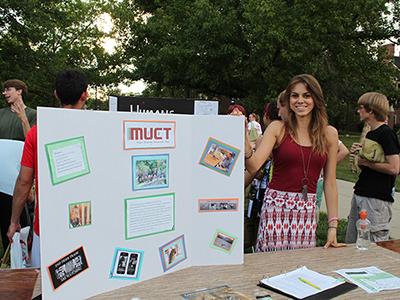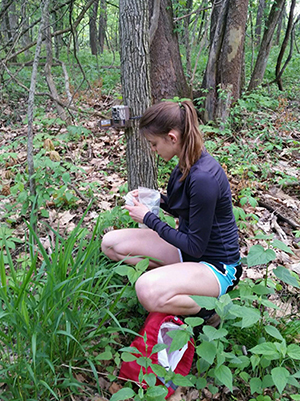Zoology major Jocelynne Samu designs her own research program

Written by Abigail Bates, CAS communications intern

Jocelynne Samu stands beside a poster about the Miami University Conservation Team.
When senior zoology major (and environmental science co-major) Jocelynne Samu realized there were limitations in going the traditional route at Miami to pursue her passion of doing research on animal predators, she decided to develop her own research project.
Samu, who has harbored a love for animals since she was a small child growing up in Salem, Ohio, came to Miami University with the full intention of majoring in zoology.
"My parents always took my brother and me to zoos," she recalls. "I've always loved animals. I remember sitting in my elementary school library and looking up cheetahs, tigers, and other big cats. I had a passion for animals and for conservation from a young age."
Since coming to Miami in 2012, Samu has involved herself in Project Dragonfly, a master's program that focuses on conservation education, and the Miami University Conservation Team, where as president she works to bring awareness to local, natural spaces in fun ways.
Samu also interned this past summer at the Conservator's Center in North Carolina for 6 weeks, working with keepers, preparing the animals' diets, feeding the animals, and maintaining their enclosures.
"They have small bearcats and lemurs as well as a handful of tigers—including a white tiger—many lions, and two leopards," she says, adding that her ultimate goal is to work with big cats.
So when a Miami professor told Samu the only chance she would have to work with predators on campus would be with spiders, she did not accept that fate. Instead, along with her research partner and close friend, Taylor Pittard, Samu went to speak with Dr. Hays Cummins to discuss her options. Dr. Cummins is a professor of geography, an affiliate and fellow for the Institute for the Environment and Sustainability, and a founding co-director of Project Dragonfly.

Jocelynne Samu prepares a camera trap in the field.
"We developed a research project that analyzes predators, specifically coyotes, in relation to invasive species, specifically honeysuckle," says Samu.
To conduct this research, Samu and Pittard set up 11 camera traps in a large area of land about 15 minutes south of Oxford.
"They're working to restore it to its natural state, so they’re removing invasive plants and putting in native plants, wetlands, and prairies," she says.
The cameras are triggered by motion, so anything that walks by day or night will get photographed.
"Then we analyze the number of species per camera that we see, and we're working towards seeing the frequency that animals are in specific habitats—whether they prefer the invasive species areas with the honeysuckle or the restored, non-honeysuckle area."
Samu explains that the dense honeysuckle could be both good and bad, as it offers protection for the animals but hinders growth of the surrounding plants.
"Once we get more data, we will start analyzing it statistically," she says. "It's a very new project. We just got the cameras set up in October 2014, so we don't really have enough evidence or data yet to make any legitimate statements, but that's the long-term goal."
Samu's research group has seen not only the more common animals such as rabbits, deer, and squirrels, but also wild turkey and weasel-like creatures that Samu suspects to be mink.
"We've also seen coyotes," she says. "There were a couple photos from the spring that had at least three, maybe four coyotes in the same shot!" She adds that it is surprising to see coyotes traveling in packs of that size in the area.

A coyote triggers a camera trap at night.
For students looking to conduct their own research, Samu recommends starting as early as you can. "It's great to be able to develop that knowledge and see how the research progresses rather than just doing a snippet and not fully understanding it," she says.
With Dr. Hays-Cummins' guidance, Samu applied for and received the Gerber Inquiry Award through Miami's Western Program to conduct her research along with Pittard.
"I would also recommend that if you don't find research with professors that you're interested in, think about developing something yourself," she says. "A lot of professors are open to helping you out, and there are many ways that you can get funding to do your research projects."
Overall, Samu feels that her courses and research experiences at Miami have prepared her well for her future career aspirations.
"I've been looking into the Nature Conservancy and other government organizations and agencies," she says. "A lot of their requirements involve experience in the field that Miami has enabled me to prepare for."
After graduation, Samu plans to take a year off before returning to Miami to complete her master's with Project Dragonfly.
"Since the classes are all online, you can take them from anywhere in the world," Samu says. "They also have partners with several zoos across the nation, so students have the option to work very closely with these facilities."
During her time off she hopes to travel, specifically to Louisiana and the Galapagos islands, and hopefully get a job or an internship. Ultimately, she has big plans for herself in the realm of conservation.
Samu feels that environmental science has given her a broad background, with knowledge that includes land, animals, plants, cultures, and economy.
"I loved my past zoological experiences, but I want to work on a more global scale, which would likely require a zoo with global connections or a government agency," she says. "If I want to save animals or help with the process, I need to work with people. Conservation is best facilitated through a team effort!"

